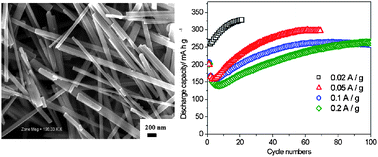Facile synthesis of NaV6O15nanorods and its electrochemical behavior as cathode material in rechargeable lithium batteries†
Abstract
A ternary

* Corresponding authors
a
Institute of Energy Technology, National Institute of Advanced Industrial Science and Technology (AIST), AIST Tsukuba Center, Umezono 1-1-1, Tsukuba, Ibaraki, Japan
E-mail:
hs.zhou@aist.go.jp
Fax: +81 (0)29 861 5799
Tel: +81 (0)29 861 5795
b Nanotechnology Research Institute, National Institute of Advanced Industrial Science and Technology (AIST), AIST Tsukuba Center 5, Higashi 1-1-1, Tsukuba, Ibaraki, Japan
A ternary

 Please wait while we load your content...
Something went wrong. Try again?
Please wait while we load your content...
Something went wrong. Try again?
H. Liu, Y. Wang, L. Li, K. Wang, E. Hosono and H. Zhou, J. Mater. Chem., 2009, 19, 7885 DOI: 10.1039/B912906E
To request permission to reproduce material from this article, please go to the Copyright Clearance Center request page.
If you are an author contributing to an RSC publication, you do not need to request permission provided correct acknowledgement is given.
If you are the author of this article, you do not need to request permission to reproduce figures and diagrams provided correct acknowledgement is given. If you want to reproduce the whole article in a third-party publication (excluding your thesis/dissertation for which permission is not required) please go to the Copyright Clearance Center request page.
Read more about how to correctly acknowledge RSC content.
 Fetching data from CrossRef.
Fetching data from CrossRef.
This may take some time to load.
Loading related content
